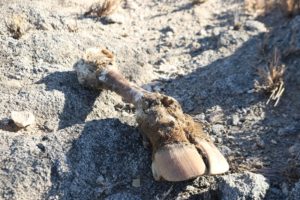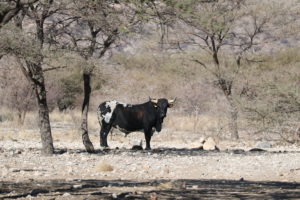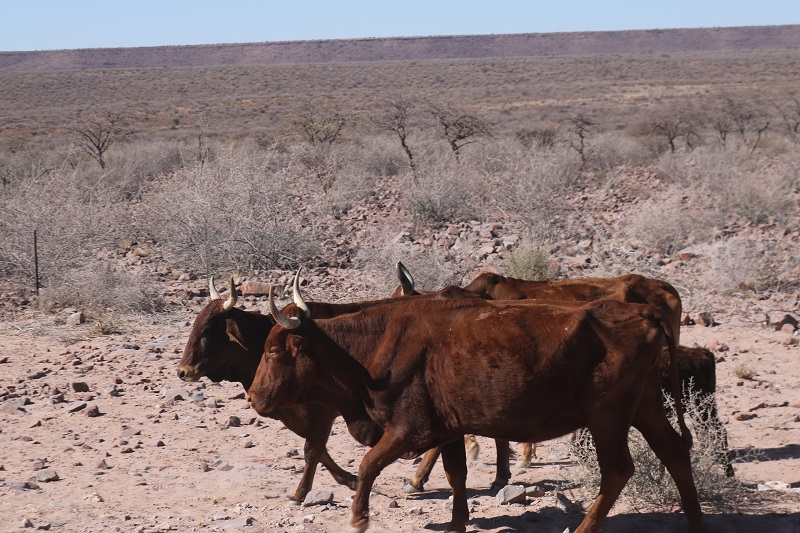In both Texas and Namibia, cattle are fixtures across the rural landscape and are among the most significant agricultural commodities. Currently in Namibia, the cattle population is greater than the human population. Beef is the highest earning agricultural export in Namibia. On July 13, 2016, Namibia was the first African country granted approval to export processed beef to the United States. Namibia takes great pride in their beef cattle. Beef producers regard cattle ownership as a status symbol. Cattle-raising is an integral part of many cultures and defines many aspects of Namibian farmers’ lives . Without cattle, many Namibians not only lose their source of revenue, but their way of life as well.
Water is a universal challenge faced by the agricultural industry, but in Namibia this challenge presents an ever greater threat to cattle farmers’ livelihoods . Namibia has had a severe drought since 2013. Texas recently underwent its own water crisis. The state was plagued by drought from 2010 to 2015, greatly impacting the beef cattle industry.
Cattle depend on large masses of land to provide ample grass for consumption. Without rainfall this feed source is quickly depleted. Dr. Herbert Schneider, owner of Farm Habis, is a renowned veterinarian in Namibia. Schneider anticipated the oncoming water shortages before the drought began and reduced his stocking rate by selling some cattle to extend the grazing period on his land. He reasoned, “I can always buy more cattle, but I can’t buy more grass.” Depending on the length of the drought, he must reevaluate his ability to continue raising or selling cattle to preserve the land. Other farmers in his region have not managed their land as carefully and have over-grazed their farms. As a result, when they do finally receive rain, their grass will take much longer to recover and replenish itself than the grass on Dr. Schneider’s farm. In Texas, many cattle owners were also forced to greatly reduce or sell their stock because the drought made grass a scarce resource; supplemental hay had to be imported from out-of-state at significantly inflated prices.
The search for suitable forage is an endless dilemma for cattle raisers. When driving in Namibia, it is not uncommon to see farmers grazing their cattle on the roadsides. Other farmers have resorted to more desperate measures, such as cutting fences of private landowners’ farms so they can feed their herds on available grasses or have them drink from limited water reserves. While I was attending a local farmer’s union meeting near Karibib, fence cutting by resettlement farmers was discussed. A resettlement farm is land purchased by the Namibian government and distributed to previously disadvantage people for agricultural purposes on a 99-year lease. At the meeting, some frustrations were shared among landowners about the resettlement farming program. Limited resources, such as grazing lands, water, and education about sustainable farming/ranching practices, continue to divide Namibians who make their livelihoods based on these resources. With the conclusion of the discussion, little resolution was evident; farmers noted how previous petitions for help from the government have been ineffective in stopping this ongoing conflict (fence cutting) between different farmers.
The majority of the farmers at the union meeting were “weekend farmers.” The drought, plus increased restrictions for exporting beef to South Africa, have made it difficult for private-landowners to make a living wage from their farms. Their privately-owned farms generally provide only supplementary income to their full-time employment. Many Namibians have found their land may be more valuable for tourism industry uses. Others are leaving their farms completely to pursue careers in the city.
The fate of many private-landowner Namibian cattle raisers is uncertain as the drought continues to make their lifestyles less feasible. Both Namibia and Texas must find ways to bring people back into agriculture to preserve those specific cultures, and our global well-being.



Leave a Reply